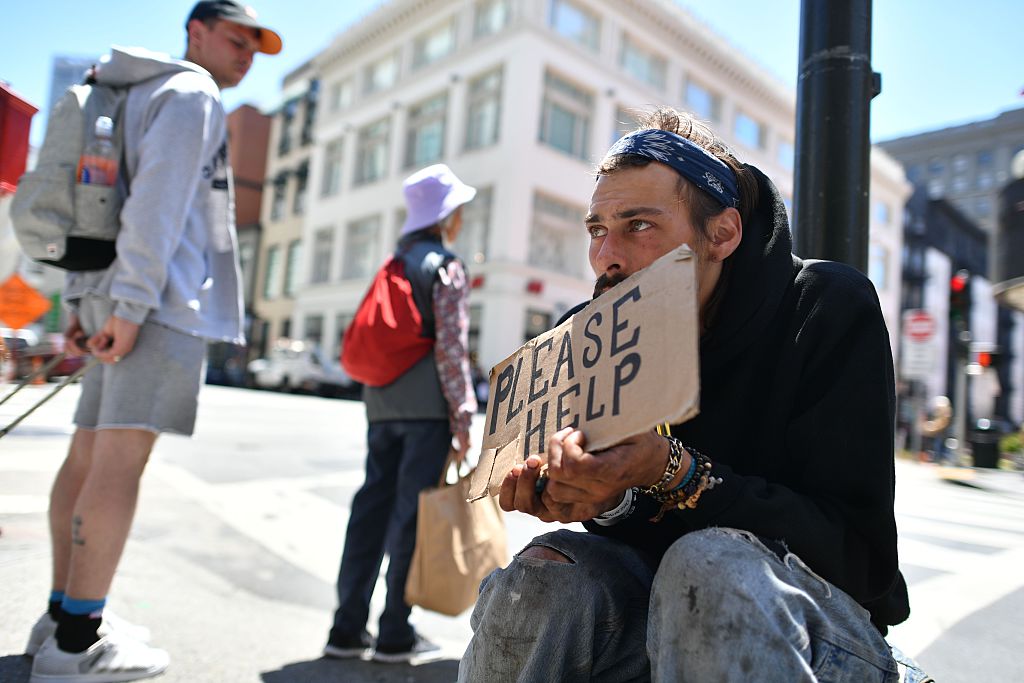The City Lights Bookstore in San Francisco opens daily until midnight, so at 10pm on a warm Friday I kiss my wife and daughters goodnight and set out from our hotel for a 45-minute walk. My route takes me up Market Street for a mile, past the headquarters of Twitter and Uber, and through crepuscular Chinatown, where black-waistcoated waiters huddle outside their closed restaurants dragging on cigarettes, until I reach the literary landmark at 261 Columbus Avenue.
I’m glad to have got there, not only because of City Lights’ association with the Beat writers whose work thrilled me when I was younger: Jack Kerouac, Neal Cassady, Allen Ginsberg, not least Lawrence Ferlinghetti, who co-founded the store with Peter Martin in 1953. I’d only got a hundred yards down Market when I realised I had a problem. I was alone and defenseless, sporting a dandyish blue velvet jacket, intermittently checking Google Maps on my phone in a way that screamed, ‘Naïf tourist’, and walking through a scene from a post-apocalyptic movie.
Clusters of grim-faced figures attended to urgent nocturnal business. Others hunched over metal trolleys containing their bundled possessions. A wizened, rheumy-eyed man crossed a wide road backwards in a wheelchair, his well-practiced stronger foot scooting him along. A young man shouted at the sky while dancing jerkily to the music in his head. And these were the people who were conscious.
Just as many lay slumped in doorways or across the sidewalk. I had never witnessed quite such disturbing destitution before, not in London, New York or Los Angeles, nor even in Iraq; the leprosy sufferers I saw there as an embedded reporter a decade ago were less menacing than this legion of opioid and meth addicts. I felt vulnerable, and later I felt fortunate and sad.
I’d last visited San Francisco in 1996. While the peninsular city’s limits have long contained communities living outside the American mainstream by choice or otherwise, recent years have brought unedifying polarisation. Tent camps, human excrement and discarded syringes have become familiar sights. As this city of circa 870,000 grows in affluence, it appears to abandon residents brought low by misfortune, disadvantage and ill-advised decisions. The prosperous citizens complain that the penurious ones are spoiling the view.
In July an anonymous woman paid for a full-page advertisement in the San Francisco Chronicle accusing the city authorities of failing their taxpayers. She complained that her lunch at the upscale café in Neiman Marcus on Geary Boulevard had been quite ruined by the presence of a young man who, having infiltrated the enclave, was ‘acting silent, strange, and trying to peer over the food counter’ while holding a pair of scissors. Naturally, she yelled for security. The man left with a glass of water, the woman with a resolve to spend $30,000 on an advert urging fellow ‘responsible, contributing members of society’ to ‘watch [their] backs — no one else is’.
It is reasonable to mock her attitude — and Twitter wasted no time in doing so. But this was an expression of a view common among San Franciscans: the authorities are culpable but inadvertent responsibility lies with another sector, the tech companies. The emergence of Airbnb, Twitter, Uber, Dropbox and many more has dynamised San Fran’s economy and property prices, gentrifying areas like Central SoMa (South of Market) and displacing their homeless populations. This has raised the street-dwellers’ visibility, and that suggests they are growing in number — a notion that turns out to be untrue.
A recent report in the Chronicle, published as part of its SF Homeless Project collaboration with other media organisations, reveals that the number of homeless declined from 8,640 in 2004 to 7,499 in 2017. Last year 35 per cent were white, 34 per cent African American, 22 per cent Hispanic and 9 per cent ‘Other’. During that period, the city doubled its expenditure on homelessness to more than $300 million, notably creating four Navigation Centres to provide temporary accommodation, counselling and advice, and around 1500 ‘supportive housing’ units.
The new Mayor, London Breed, wants to build thousands more units. The plan is popular among San Franciscans, though some find their enthusiasm waning when sites are earmarked in their own neighborhood. There is talk of raising extra funds by taxing the tech companies, and a few are already addressing the issue as part of their corporate social responsibility. Plainly, there is substantial will to enact change. But the issues are vast and deep-rooted, so progress is slow. For now, San Francisco after dark remains the domain of acutely troubled souls for whom the sidewalk is their bed.
On Friday night, the hushed atmosphere and engrossing literature of City Lights sets the area’s problems at a remove. I stock up on branded T-shirts, button badges and bookmarks, a poster of Kerouac and Cassady, and even a few books, among them Malcolm Lowry’s Selected Poems, published by City Lights in 1962 and suffused with resonant despair for a desolate world like ‘a river in spate / Where drowning forms, downswept, gesticulate’. Then I get an Uber back to the steel security gate of our cheap hotel. I return to my sleeping family, and quietly recline on a hard-sprung old mattress. It feels like the height of luxury.
Keiron Pim, the author of Jumpin’ Jack Flash: David Litvinoff and the Rock’n’Roll Underworld (2016), is now writing a biography of the novelist Joseph Roth


















